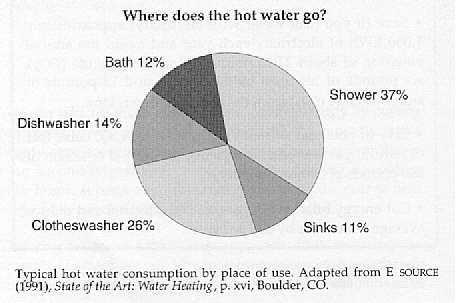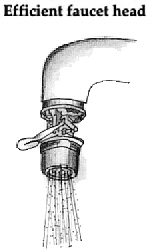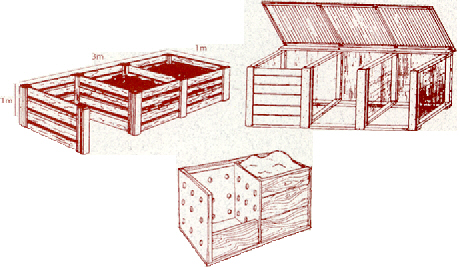short term approaches
Retrofitting existing appliances or replacing ageing household infrastructure with better technological choices are simple ways you can make a difference to save energy, water, and long-term operational costs. Here are a just a few things you can do:
Conserving Electricity
Lighting:
- Although incandescent light bulbs are cheap, they typically have a very short life span and are highly inefficient. Only 10% of the electricity used to run an Incandescent bulb is emitted as light, 90% is lost to heat (RMI 1995) !! In comparison compact fluorescent bulbs (CFLs) are four times more efficient than incandescents and last 9 to 13 times as long (RMI 1995). CFL can be cost-effective in the long run, with a pay back period of three to four years.
Home Heating:
- When it comes time to replace your furnace, you would be wise to consider purchasing a high efficiency furnace. The most efficient furnace currently available has a 93% efficiency rating and costs $1, 450. The next best purchase is an 80% efficiency furnace available for $900. An average efficiency furnace (45-50 %) costs about $800. The energy savings made possible by a 93% efficient furnace in terms of reduction of heat loss result in savings after only 5 years from the lower heating bills.
Solar Ovens:
- Ovens that use the sun's energy are a great way to cook lunch and supper while keeping the house cool in the summer! Many designs exist with home-made versions costing next to nothing because they make use of recycled materials (e.g., mylar reflective material from the interior of potato chip bags). Commercially produced models can cost up to $250 for materials with operating costs of zero. Information and solar oven plans are available from a variety of sources including at www.humboldt.edu/~ccat/sub/solovn.htm
Water Heating:
-
Water heating is estimated to be the second
largest energy expense for an average home, with cost of home heating or
cooling being the largest. Improving
the efficiency of your hot water supply and reducing the amount of water
we use is key to reducing this cost.
-
Hot water tank insulation:
You can save as much as 10% on your heating bill by installing inexpensive, tank-insulating blankets. This saving is significant considering a family of four may spend as much as $600 per year to heat water (Environment Canada 1995). Insulation blankets are available for approximately $35 at hardware stores - an investment you can see a return on in less than a year, depending on your particular water heater (RMI, 1995).Insulating hot and cold water pipes within a safe distance from the hot water tank will also increase your heating efficiency. A heat trap pipe is another hot water tank retrofit that can be done to reduce heat loss by preventing heat from rising up the pipe. Heat trap kits can be purchased for under $25 with the costs being recovered in just two years (Environment Canada 1995). Setting your water heater at 50o and turning it down when you go on vacation are other simple things you can do to save money and energy.
-
Hot water tank insulation:
Conserving Water
Installation of Efficient Shower and Faucet Heads:
Installing an efficient shower head can cut water use by one third to one half at a minimal cost. The flow rate of a low-flow shower head is 9.5 litres per minute as compared to an average shower head flow-rate of 15-20 litres per minute. In terms of savings, a typical household could save up to 1000 litres of water each week (Environment Canada 1995).There are now numerous models of efficient shower heads available for purchase. Shower heads are very easy to install and can be obtained from all major plumbing supply stores. Similarly, installing high efficiency faucet heads is very simple and can save 4 to 7 percent of your total home water consumption (RMI 1995). Installing faucet aerators is another good idea to reduce water use by making the water flow more effective for washing.
Estimated annual environmental savings from retrofitting showers and faucets in a typical residential home: (Source: Rocky Mountain Institute 1995)
- -17,000 gallons of water
-1,080 kWh of electricity = 2,010 pounds of carbon dioxide , 6 pounds nitrogen oxides, 13 pounds of sulphur.
- 4,800 cubic feet of natural gas = 580 pounds of carbon dioxide.
Low Flush Toilets:
- Of the water used within an average household, 30% is flushed down the toilet. Toilets older than ten years are likely to be water-wasting, using about 18 litres or more of water per flush. In comparison, a super-efficient low flush toilet, uses only 6 litres per flush!! However, it is not necessary to purchase an entirely new toilet as simple things can be done to retrofit an existing toilet to make it more efficient. Simply placing a brick into the back of your toilet can displace and save water. Another popular water conservation method is to install a toilet dam.
Rainwater Collection and Xeriscaping:
-
To conserve water for outdoor irrigation, it
is wise to consider capturing, storing and using rain-water. This can
be done very simply by using wooden barrels to catch the water funnelled
from your roof down the rain gutters. Another technique to consider
is xeriscaping. Xeriscaping involves planting drought resistant, locally
adapted plants as opposed to plants which need a lot of water to grow
successfully.
Other easy to follow water conservation tips are available from Environment Canada's 1995 publication: "Water: No time to waste: A consumer's guide to water conservation". This publication and additional information can be accessed on line at: http://www.ec.gc.ca/water/index.htm.
Gardening and Composting
-
Urban food production, whether outdoors or in
a year-round greenhouse, is a fun and relatively easy means for a neighbourhood
to become more self-reliant while saving money. To create your own
garden composting of neighbourhood waste is an easy way to build-up rich,
productive soil.
Setting up Your Own Composter:
-
A great way to save money on fertilizers while
promoting an organic style of gardenting is thorugh composting. There
are numerous brochures and informative books and web sites available to help
you get your composting system started:
Alberta Environmental Protection's brochure: "Taking action through Backyard Composting to Reduce Household Waste": available from Alberta's Recycle Info Line 1-800-463-6326.
" The Urban/Suburban Composter" by Cullen and Johnson, 1992.
The Greater Vancouver Regional District: Waste Reduction at home, Composting Info website: http://www.gvrd.bc.ca/waste/bro/swbckyr.htmlHousehold composting can significantly reduce the amount of waste sent to the landfill. Environment Canada estimates that approximately 25% of garbage in municipal landfill sites is organic household waste which could be composted!
Outdoor composting bins are simple and inexpensive to build. Old fence boards, used wooden planks, or old pallets can be used to assemble a simple composting unit.
Building a small, seasonal greenhouse
- To extend your growing season, small non-permanent greenhouses are inexpensive and easy to construct and disassemble. A basic floorless greenhouse consists simply of a polyethylene covered wood frame. This type of greenhouse can be designed to suit any desired size specification and can be folded down and stored very easily. A greenhouse of this type should be built in early spring but may not be necessary during warmer summer months. See: http://www.ag.usask.ca/cofa/departments/hort/hortinfo/misc/greenhou.html for more information.
NextPage



